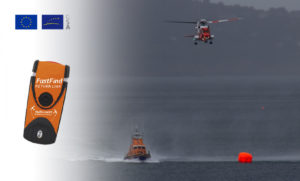The first Galileo Return Link Service Personal Location Beacon (PLB) developed under the H2020 funded Helios project will be released in December 2020 across 18 European countries.

The FastFind ReturnLink PLB transmits the user’s unique ID and GNSS location via the global network of Cospas-Sarsat search and rescue satellites
In close collaboration with the European GNSS Agency and within framework of the H2020 HELIOS project, Orolia has been working to equip SAR beacons with the breakthrough Galileo Return Link Service. Declared operational in January 2020, the Galileo Return Link Service is a unique feature of Galileo – Europe’s Global Navigation Satellite System – it allows people in distress to receive an automatic acknowledgement that their signal has been received and their location is known.
How does Return Link Service actually work?
The FastFind ReturnLink PLB transmits the user’s unique ID and GNSS location via the global network of Cospas-Sarsat search and rescue satellites. When a person in distress activates the emergency beacon, the Galileo satellites capture the signal and transmit it to a set of Ground Segment Facilities namely the Galileo Return Link Service Provider (RLSP) based in Toulouse. Once the location of the person in distress is determined, an automatic message is sent through the Galileo satellites confirming to the user that their position has been detected and the information has been routed to the relevant government authorities. With the FastFind ReturnLink PLB the person in distress – whether on land or at sea- will see a blue light blinking on their beacon, around 10-15 minutes after confirmation that the distress signal and the beacon’s location has been detected.
”At the GSA, our objective is to ensure that EU Space investments and our work on Galileo services are bringing added value to citizens. With the first Search and Rescue beacon worldwide deployed thanks to the H2020 project HELIOS, we can proudly state that our actions made a difference for innovation but also for the citizens. The ones who need to use this Personal Location Beacon will be reassured by the Return Link Service” confirmed Rodrigo da Costa, GSA Executive Director.
Galileo’s impact on Search and Rescue (SAR)
Galileo’s immediate impact on Search and Rescue (SAR) has been the addition of 26 new satellites, allowing for greater global coverage and faster detection of the 406MHz distress frequency. Coupled with Galileo’s robust signal, SAR beacons deliver greater positioning accuracy.
Galileo’s development is part of the European Union’s preparations for upgrading the international distress beacon locating organisation Cospas-Sarsat’s Search and Rescue (SAR) Ecosystem under the MEOSAR program, which requires new earth -based antenna and a network of 72 GNSS satellites, combining the US GPS, the EU Galileo and the Russian Glonass systems. The Return Link Service is a unique feature provided by Galileo within its contribution to Cospas-Sarsat.
Return Link Service provides confidence to the people in distress
By sending a confirmation to the user that the distress signal from the beacon has been localised by the Cospas-Sarsat system and the information has been relayed to the relevant Search and Rescue authorities, the Return Link Service provides confidence and reassurance to the people in distress that help is on the way.
Chris Loizou, Vice President of Maritime at Orolia, said: “The Search and Rescue community has long known the survival impact of dealing with a distress situation on your own, either as a solo adventurer or as a group that feels isolated due to the lack of communication with the outside world. The Return Link reassurance signal will reduce the chances of rash decisions taken by those who feel they have nothing to lose, such as leaving the site of an accident or attempting to swim to safety. The psychological impact of knowing that help is on the way cannot be underestimated, and this PLB will provide invaluable peace of mind for those in distress.”
The Galileo Return Link Service increases survival rates by giving an important psychological boost to people in distress. It is estimated by Cospas-Sarsatthat the international SAR system, with the contribution of the Galileo Search and Rescue service, saves more than 2000 lives a year.
*The Galileo Return Service Link enabled beacons will be so far available in the following countries: Croatia, Cyprus, Denmark, Faroe Islands (DK) France, Germany, Greece, Greenland (DK), Iceland, Ireland,Israel, Italy, Latvia, Liechtenstein, Norway, Sweden, Switzerland, United Kingdom.
Source: GSA

Hi
1.When will these PLB’s be released for sale in the UK
2.If and when I purchase one will it work in Australia